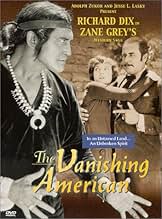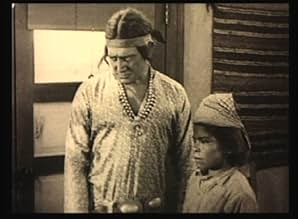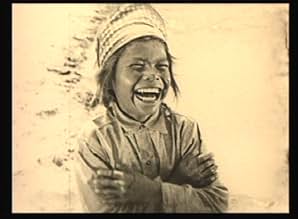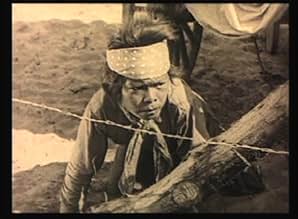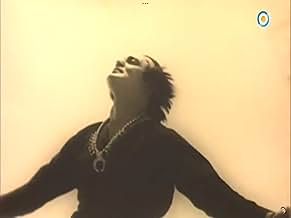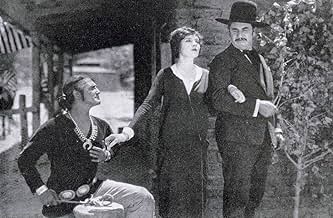AVALIAÇÃO DA IMDb
6,9/10
385
SUA AVALIAÇÃO
Adicionar um enredo no seu idiomaA Navajo tribe suffers mistreatment by an Indian-hating agent who steals their horses. When WWI breaks out, a teacher convinces the tribe leader that enlisting will lead to better treatment.A Navajo tribe suffers mistreatment by an Indian-hating agent who steals their horses. When WWI breaks out, a teacher convinces the tribe leader that enlisting will lead to better treatment.A Navajo tribe suffers mistreatment by an Indian-hating agent who steals their horses. When WWI breaks out, a teacher convinces the tribe leader that enlisting will lead to better treatment.
- Direção
- Roteiristas
- Artistas
- Prêmios
- 2 vitórias no total
John Webb Dillion
- Naylor
- (as John Webb Dillon)
Gary Cooper
- Extra
- (não creditado)
George Magrill
- The First Nophaie
- (não creditado)
- Direção
- Roteiristas
- Elenco e equipe completos
- Produção, bilheteria e muito mais no IMDbPro
Avaliações em destaque
After a few decades interval I re-watched "The Vanishing American" (1925) with Richard Dix, Lois Wilson, Noah Beery, Sr., Malcolm McGregor, Nocki, Charles Stevens, Bernard Siegel, Shannon Day, and others. I went in this time with the attitude that I'd watch as if it were 1925, not 2020, then assess the film from both ends, realizing that the finished assessment is still my own opinion and might differ radically from anyone else, or even everyone else. Overall, the picture, directed by George B. Seitz (known perhaps best as the director of most of the "Andy Hardy" series), is not just a Western taken from a Zane Grey novel, but closer to an attempt at an "epic" saga of a series of tribal leaders who are called Nophaie of what have become known as American Indians. The film begins before neolithic times, in a time where the geography is the beginning and the people follow into the geography. We then have a neolithic presence, then a sort of tribal presence, then the American Indian, then the arrival of Spanish invaders from down in the Mezo-American regions where they've already invaded, then the somewhat contemporaneous era of American Indians on a "reservation" mandated by whites who now rule the nation. Richard Dix is the current Nophaie of all the clans and/or tribes of the Western region plotted in the film. His instant nemesis is not the current white Indian agent of the area and the reservation, but rather his assistant, Noah Beery, Sr., an evil, money-grubbing, harassing, anti-Indian sort to whom viewers take an immediate dislike because of unbecoming behaviors at several turns. The local white teacher of all the Indian children is Lois Wilson. The plot runs as a typical Western would, except Wilson and Dix fall for each other, knowing that such is not going to be accepted; and the plot favors the Indian side over the white side which is shown to be duplicitous, sometimes out-and-out evil, and under a government that seems to talk out of both sides of its mouth, though follows its own path as it sees fit. And Manifest Destiny is behind all. I'll not give the entire plot, though we do follow the Indians through WWI and their return. I found the film as a 1925 vehicle very satisfying and well done. It manifests itself as any white produced film in America in 1925 would have done, though it gave the Indian far more a share than nearly any other film of the time would have dared, and the word "dared" is the operative one.
Now, shift gears and come up to 2020. It's interesting looking at the comments of viewers who have left criticisms of the film on the IMDb. Nearly all give the film from 8 out of 10 to 10 out of 10. EXCEPT 1. The one has the moniker of 'trujillotribe'. The Trujillo homesteads of Colorado were formed in the 1860s by Hispano Americans who came there when their lands were annexed from Mexico by America. The cultural differences in everything from farming to just being who each was caused conflicts that raged for decade after decade. The one exception on the IMDb as to rating "The Vanishing American" says the plot of the film is ridiculously false, and to quote the review, "Incorrect and disrespectful, regardless of the date released." It goes on in a vein of such feelings. I wondered when I finished watching this time if my liking the film wasn't based on my learning history in the 50s and 60s when Manifest Destiny was the theme of every history book. What does that entail? In a nutshell, it accepts - and that, too, is the operative word - it accepts the fact that white Europeans came to this land in 1492 and have with their doctrine of Christianity rightfully usurped all the land and driven out heathenism and savagery.
I accept that we've come to a point in our culture where accepting Manifest Destiny in its cultural overview of our history is not only outdated, but not 'history' in the proper sense of the word. It's very one-sided. But we've come to a time where the past is being dumped as utterly BAD. "The Vanishing American" actually is a very fine film in its regard to the American Indian of 1925. The film, considering when it was made, is lucky to have found a good audience with its theme. It had to have a Richard Dix as star, or few would have gone to see it. Also in the cast in a very prominent rôle is Charles Stevens. The name isn't known much today - a shame, as he was the grandson of Geronimo - and a terrific actor in his own right, plus a good tennis buddy of Douglas Fairbanks, Sr.! He could easily have essayed the rôle Richard Dix does, but would have found his audience not as wide as movie moguls would have needed to pay the bills. Interestingly, too, he plays the part of an Indian (and, of course, IS one) who has a thing for Gekin Yashi, NOT played by a Native American female, but by Shannon Day, a New York City born white woman who played several Indian and Mexican parts in her 29 film career!
Not to utterly belabor my thoughts, I enjoyed seeing this again, and I realize that I now live in a time that accepting white people playing native American parts is basically taboo, especially when the theme of the film is one where the whites are not necessarily the good guys. I found an interesting commentary by Richard Allen and Tom Holm which has this to say about the film: "...Were George Seitz and Zane Grey attempting to demonstrate that Christianity alone cannot save Native Americans? The film has the rudiments of an overriding theme of inevitable despair. In short, the fate of the cinematic Native American soldier is heroism for naught..."
I think the film should be watched, first, as a cinematographic masterpiece (Harry Perry and Charles Edgar Schoenbaum did the cinematography, much of which is borrowed again almost EXACTLY in "The Searchers" by John Ford), second, as an attempt by early Hollywood to exact a form of retribution for Manifest Destiny, whether it is appreciated a hundred years later or not, and, third, just because it plays very well without trying to belittle a race mercilessly and tells a good, if tragic, story.
Now, shift gears and come up to 2020. It's interesting looking at the comments of viewers who have left criticisms of the film on the IMDb. Nearly all give the film from 8 out of 10 to 10 out of 10. EXCEPT 1. The one has the moniker of 'trujillotribe'. The Trujillo homesteads of Colorado were formed in the 1860s by Hispano Americans who came there when their lands were annexed from Mexico by America. The cultural differences in everything from farming to just being who each was caused conflicts that raged for decade after decade. The one exception on the IMDb as to rating "The Vanishing American" says the plot of the film is ridiculously false, and to quote the review, "Incorrect and disrespectful, regardless of the date released." It goes on in a vein of such feelings. I wondered when I finished watching this time if my liking the film wasn't based on my learning history in the 50s and 60s when Manifest Destiny was the theme of every history book. What does that entail? In a nutshell, it accepts - and that, too, is the operative word - it accepts the fact that white Europeans came to this land in 1492 and have with their doctrine of Christianity rightfully usurped all the land and driven out heathenism and savagery.
I accept that we've come to a point in our culture where accepting Manifest Destiny in its cultural overview of our history is not only outdated, but not 'history' in the proper sense of the word. It's very one-sided. But we've come to a time where the past is being dumped as utterly BAD. "The Vanishing American" actually is a very fine film in its regard to the American Indian of 1925. The film, considering when it was made, is lucky to have found a good audience with its theme. It had to have a Richard Dix as star, or few would have gone to see it. Also in the cast in a very prominent rôle is Charles Stevens. The name isn't known much today - a shame, as he was the grandson of Geronimo - and a terrific actor in his own right, plus a good tennis buddy of Douglas Fairbanks, Sr.! He could easily have essayed the rôle Richard Dix does, but would have found his audience not as wide as movie moguls would have needed to pay the bills. Interestingly, too, he plays the part of an Indian (and, of course, IS one) who has a thing for Gekin Yashi, NOT played by a Native American female, but by Shannon Day, a New York City born white woman who played several Indian and Mexican parts in her 29 film career!
Not to utterly belabor my thoughts, I enjoyed seeing this again, and I realize that I now live in a time that accepting white people playing native American parts is basically taboo, especially when the theme of the film is one where the whites are not necessarily the good guys. I found an interesting commentary by Richard Allen and Tom Holm which has this to say about the film: "...Were George Seitz and Zane Grey attempting to demonstrate that Christianity alone cannot save Native Americans? The film has the rudiments of an overriding theme of inevitable despair. In short, the fate of the cinematic Native American soldier is heroism for naught..."
I think the film should be watched, first, as a cinematographic masterpiece (Harry Perry and Charles Edgar Schoenbaum did the cinematography, much of which is borrowed again almost EXACTLY in "The Searchers" by John Ford), second, as an attempt by early Hollywood to exact a form of retribution for Manifest Destiny, whether it is appreciated a hundred years later or not, and, third, just because it plays very well without trying to belittle a race mercilessly and tells a good, if tragic, story.
Although by today's standards The Vanishing American is over the top and melodramatic it still has a fine message about the American Indian and their place in the American dream. The sad truth was that this continent did belong to them and we took it from them.
Nothing to be either proud or ashamed of. A society that ranged from hunting and gathering to the beginnings of agricultural gave way to a to an industrial and full blown agricultural society. Just the sociological way of things. Everything gives way to something in time.
That being said, the tragedy of the American Indian was not often told in these years from the Indian point of view. As a writer Zane Grey was steeped in western lore and if a white man could tell the story he could.
After a prologue showing the subjugation, we see the desert tribes of today living on government handouts, trying to maintain respectability but the victims of a corrupt Indian agent played by Noah Beery. That was the way it was back then, under Democratic or Republican administrations, the Department of the Interior was a patronage trough and characters like Noah Beery were more common than we would care to admit.
Richard Dix plays a charismatic leader of his people who actually forms an Indian battalion to fight in what was called then, The Great War. It was reasoned we fight for America as good Americans we'll be treated as such when we return. Instead its business as usual as Beery has banished the tribe to desert scrub lands. Time to return to the fighting ways of our ancestors maybe.
As Dix's character is presented and he specialized in playing noble heroes on the silent screen and when talkies arrived, the personal tragedy of this tribe is that Dix comes along about four generations too late. He's the kind of leader who might have made a difference back in the day, but can only see the futility of what his tribe is about to do.
The Vanishing American shot in what became known as John Ford's Monument Valley was a big budget item for Paramount back in the day. It's got the sweep and grandeur of a John Ford western and a little bit of the influence of Paramount's number one director Cecil B. DeMille in this one who made a spectacle film or two of note.
Though melodramatic, The Vanishing American should still be viewed for the lessons it imparts to today's audience.
Nothing to be either proud or ashamed of. A society that ranged from hunting and gathering to the beginnings of agricultural gave way to a to an industrial and full blown agricultural society. Just the sociological way of things. Everything gives way to something in time.
That being said, the tragedy of the American Indian was not often told in these years from the Indian point of view. As a writer Zane Grey was steeped in western lore and if a white man could tell the story he could.
After a prologue showing the subjugation, we see the desert tribes of today living on government handouts, trying to maintain respectability but the victims of a corrupt Indian agent played by Noah Beery. That was the way it was back then, under Democratic or Republican administrations, the Department of the Interior was a patronage trough and characters like Noah Beery were more common than we would care to admit.
Richard Dix plays a charismatic leader of his people who actually forms an Indian battalion to fight in what was called then, The Great War. It was reasoned we fight for America as good Americans we'll be treated as such when we return. Instead its business as usual as Beery has banished the tribe to desert scrub lands. Time to return to the fighting ways of our ancestors maybe.
As Dix's character is presented and he specialized in playing noble heroes on the silent screen and when talkies arrived, the personal tragedy of this tribe is that Dix comes along about four generations too late. He's the kind of leader who might have made a difference back in the day, but can only see the futility of what his tribe is about to do.
The Vanishing American shot in what became known as John Ford's Monument Valley was a big budget item for Paramount back in the day. It's got the sweep and grandeur of a John Ford western and a little bit of the influence of Paramount's number one director Cecil B. DeMille in this one who made a spectacle film or two of note.
Though melodramatic, The Vanishing American should still be viewed for the lessons it imparts to today's audience.
What a great surprise this movie is. This silent is a sleeper, a classic, wonderful film that does all the great things a soundless movie is capable of doing. Most importantly, this may be one of the most genuinely sympathetic movies ever about American Indians, because it does so without preaching, without portraying them as these mystical, magical humans, that, because they do things like use every piece of the buffalo they kill, are somehow better than all of us. You know the stereotype. It seems like Hollywood has never found a smart middle ground when it comes to portraying Indians: they are either savages or god-like innocents, but never normal. In The Vanishing American, the Indians are just regular people, largely pushed and pulled by fate and the inexorable spreading of the white way of life.
Here, we see the hurt inflicted on Indians in small ways, like a farm being taken by the Indian Agent from one man while he is away at war, or a tribe member taken to be a servant of the Agent, and dying in his service, and the pain this causes his survivors; we feel the sadness of the characters without being forced through a lecture.
At the same time, the movie is epic in nature, taking us through several millennia of time, and staging those massive battle scenes containing hundreds of extras that the silents, to me, do more effectively than the talkies ever could (perhaps it is the inherently haunting nature of all silent film that makes it seem so).
Richard Dix is acceptable as an Indian leader, but Noah Beery steals the show, playing one of the slimiest and sleaziest villains ever; he even kicks an Indian sitting at his office's doorstop, and not once, but twice, to get him out of the way!
This movie also takes patriotism very seriously; tears come to the school teacher's eyes when her class of young Indians says the Pledge of Allegiance. Religion, too, is treated with seriousness, as modern Hollywood never does; Christianity and the New Testament are held with reverence, but again, not too preachy.
I highly recommend this film to all silent film affectionados, as well as those interested to see a unique and oddly progressive film about Native Americans that was made in the 1920's.
Some small thoughts: (1) Early in the film, some Indians meet up with Spanish Conquistadors. The Indians are much more naked than we normally see them; No clothing at all up their hips: a little unnerving! (2) During an early battle scene, an invading tribe is attacking the cliff dwellers; the invaders climb tall ladders to reach the upper ledges. At one point, several ladders full of climbing invaders are seen; one of the ladders is pushed back, and a ladder full of invaders falls backwards, the men on it doomed to fall to their presumed deaths; if you look closely, though, the men on that ladder are clearly dummies.
(3) When Kit Carson's soldiers first hurry off to battle, the first carriage we see pulled by horses and supporting a cannon clearly loses a wheel as it flies down a hill. (4) Racial incongruity #1: The white Richard Dix, with make-up on to darken his features to make him look like an Indian, wearing a soldier's World War I uniform and fighting in the trenches. Racial incongruity #2: an Indian Chief introduced in a title, played by Bernard Siegle!
(5) When the Indian children in the school recite the Pledge of the Allegiance, they have their arms extended out in a manner that to modern eyes may seem like a fascist salute; is this how they used to do it? (6) At one point, Richard Dix is standing on one of the great stone arches of the American West, tossing feathers from his staff into the wind; the first feather he tosses is blown by the wind back to him, and sticks to his arm! He quickly swipes it away, though, and continues his scene.
Here, we see the hurt inflicted on Indians in small ways, like a farm being taken by the Indian Agent from one man while he is away at war, or a tribe member taken to be a servant of the Agent, and dying in his service, and the pain this causes his survivors; we feel the sadness of the characters without being forced through a lecture.
At the same time, the movie is epic in nature, taking us through several millennia of time, and staging those massive battle scenes containing hundreds of extras that the silents, to me, do more effectively than the talkies ever could (perhaps it is the inherently haunting nature of all silent film that makes it seem so).
Richard Dix is acceptable as an Indian leader, but Noah Beery steals the show, playing one of the slimiest and sleaziest villains ever; he even kicks an Indian sitting at his office's doorstop, and not once, but twice, to get him out of the way!
This movie also takes patriotism very seriously; tears come to the school teacher's eyes when her class of young Indians says the Pledge of Allegiance. Religion, too, is treated with seriousness, as modern Hollywood never does; Christianity and the New Testament are held with reverence, but again, not too preachy.
I highly recommend this film to all silent film affectionados, as well as those interested to see a unique and oddly progressive film about Native Americans that was made in the 1920's.
Some small thoughts: (1) Early in the film, some Indians meet up with Spanish Conquistadors. The Indians are much more naked than we normally see them; No clothing at all up their hips: a little unnerving! (2) During an early battle scene, an invading tribe is attacking the cliff dwellers; the invaders climb tall ladders to reach the upper ledges. At one point, several ladders full of climbing invaders are seen; one of the ladders is pushed back, and a ladder full of invaders falls backwards, the men on it doomed to fall to their presumed deaths; if you look closely, though, the men on that ladder are clearly dummies.
(3) When Kit Carson's soldiers first hurry off to battle, the first carriage we see pulled by horses and supporting a cannon clearly loses a wheel as it flies down a hill. (4) Racial incongruity #1: The white Richard Dix, with make-up on to darken his features to make him look like an Indian, wearing a soldier's World War I uniform and fighting in the trenches. Racial incongruity #2: an Indian Chief introduced in a title, played by Bernard Siegle!
(5) When the Indian children in the school recite the Pledge of the Allegiance, they have their arms extended out in a manner that to modern eyes may seem like a fascist salute; is this how they used to do it? (6) At one point, Richard Dix is standing on one of the great stone arches of the American West, tossing feathers from his staff into the wind; the first feather he tosses is blown by the wind back to him, and sticks to his arm! He quickly swipes it away, though, and continues his scene.
TThe Vanishing American (1925) - From Paramount Pictures and director George B. Seitz comes this adaptation of Zane Grey's novel. After a lengthy prologue (that's worth the price of admission alone) that details the history of humankind in America, particularly those of the Southwest US, the plot settles in: a devious Indian Affairs agent (Noah Beery Sr.) tries every trick in the book to rip off the Natives on the nearby reservation. He's often thwarted by the stoic Nophaie (Richard Dix), a noble warrior. Nophaie is secretly in love with white schoolteacher Marion (Lois Wilson), but fears that she has her heart set on square-jawed cavalry man Earl Ramsdale (Malcolm McGregor). Also featuring Guy Oliver as Kit Carson, and Nocki as a native boy.
The history and culture portrayed may be dubious, but I admire any attempt at this time to show Native Americans in a positive light. And how many Westerns turn into WWI movies, too? The real star in this one is the scenery, including Monument Valley. Gary Cooper is supposedly an extra in this, but I didn't notice him. This is mainly hokum, but it's enjoyable hokum.
The history and culture portrayed may be dubious, but I admire any attempt at this time to show Native Americans in a positive light. And how many Westerns turn into WWI movies, too? The real star in this one is the scenery, including Monument Valley. Gary Cooper is supposedly an extra in this, but I didn't notice him. This is mainly hokum, but it's enjoyable hokum.
A great epic. The proof that George B. Seitz was a great director. A very fine cast. Dix and Wilson are outstanding. The story takes you from the time of the dinosaurs to our days in a very convincing way.
Você sabia?
- CuriosidadesThe legend that John Ford "discovered" Monument Valley (or John Wayne did and Ford took credit for it), or Harry Goulding (the trading post owner there) introduced Ford to this unique location in 1938 for No Tempo das Diligências (1939), is disproved by the fact that this movie was filmed there in 1925.
- ConexõesFeatured in The House That Shadows Built (1931)
Principais escolhas
Faça login para avaliar e ver a lista de recomendações personalizadas
Detalhes
Bilheteria
- Faturamento bruto nos EUA e Canadá
- US$ 286.809
- Tempo de duração
- 1 h 50 min(110 min)
- Mixagem de som
- Proporção
- 1.33 : 1
Contribua para esta página
Sugerir uma alteração ou adicionar conteúdo ausente

